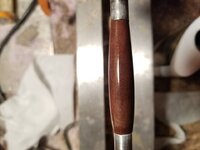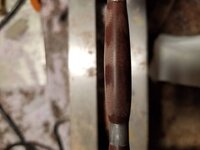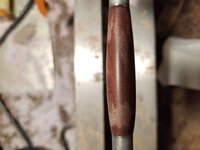You are using an out of date browser. It may not display this or other websites correctly.
You should upgrade or use an alternative browser.
You should upgrade or use an alternative browser.
Help, not sure what I'm doing wrong with CA finish.
- Thread starter Dr_N
- Start date
Signed-In Members Don't See This Ad
Signed-In Members Don't See This Ad
RKB
Member
Welcome to the IAP Dr_N. This is an awesome forum. Your skills will improve with the help of those here, I know mine did. :biggrin:
Rod
Not sure if I've sanded through the CA?,<----------this
Rod
Not sure if I've sanded through the CA?,<----------this
Dr_N
Member
Thanks for the quick replies. Can I reapply CA from here, or should I sand it all off and start fresh?
Sent from my SM-G955U using Tapatalk
Sent from my SM-G955U using Tapatalk
JimB
Member
Yes, you sanded thru the CA.
coffeeslug
Member
Thanks for the quick replies. Can I reapply CA from here, or should I sand it all off and start fresh?
Sent from my SM-G955U using Tapatalk
Go ahead and throw another coat on there, you should be fine.
Agreed. I would throw 3 or 4 coats on there to be safe.
I'm learning that you don't need to sand for all that long on each grit. I still sand through regularly, but cutting the sanding time seems to help and the finish is still good.
Sent from my iPhone using Penturners.org mobile app
I'm learning that you don't need to sand for all that long on each grit. I still sand through regularly, but cutting the sanding time seems to help and the finish is still good.
Sent from my iPhone using Penturners.org mobile app
greenmtnguy
Local Chapter Leader
Thanks for the quick replies. Can I reapply CA from here, or should I sand it all off and start fresh?
Tell us more about your application process. How many coats of what thickness CA. What did you sand the CA with before micromesh.
Try this https://youtu.be/eL9T-H8Hfv8
Dr_N
Member
I sanded with 400 after turning. Applied 3 coats of thin ca then wet sanded with 1000. Applied 3 more coats of thin, then 3 coats of medium ca. Wet sanded again with 1000 very lightly then moved to 1500 mm. I think I may be too heavy handed with the sanding. I sand each blank for 20-30 seconds at watch grit of I'm. Probably sanded with the 1000 wet for 10-15 seconds.
Sent from my SM-G955U using Tapatalk
Sent from my SM-G955U using Tapatalk
Depending on the wood, reapplication can be just fine. With some woods/styles you con get a noticeable difference that looks "splotchy". In my experience this is especially true if you wet sand or clean with denatured alcohol, and the wood is figured, oily, or lighter in color.
For what it's worth, I would put a few more coats on it and live with the results... I'm not as picky as Tony
For what it's worth, I would put a few more coats on it and live with the results... I'm not as picky as Tony
Dr_N
Member
That video was very helpful, thanks!Thanks for the quick replies. Can I reapply CA from here, or should I sand it all off and start fresh?
Tell us more about your application process. How many coats of what thickness CA. What did you sand the CA with before micromesh.
Try this https://youtu.be/eL9T-H8Hfv8
Sent from my SM-G955U using Tapatalk
Dr_N
Member
Thanks for the help all! I tried applying more ca before I sanded it bare and out came out pretty well. There is a little discoloration that can be seen on the bottom of the blank in the second picture. Not happy about it but I can live with it for the learning experience. You all were fast and a ton of help!View attachment 172157
Sent from my SM-G955U using Tapatalk

Sent from my SM-G955U using Tapatalk
MRDucks2
Member
Dr_N
Member
Thanks!
Sent from my SM-G955U using Tapatalk
Bikerdad
Member
20-30 seconds with each grit? Seems to be way more than you need. Go for 10-15. And a light touch.
leehljp
Member Liaison
Coating with CA using paper towel ends up with probably 1/500 of an inch to 1/250th of an inch of thickness. 3 or 4 coats of CA with paper towel will amount to 1/100th of an inch thick and sanding through is quick and easy. Paper towel (PT) is the applicator of choice but it absorbs 10 to 1 the amount of CA vs what goes on the blank.
If you need to build up, use medium or thick. It might take a 2 to 5 minutes to cure in cool weather but the build up of CA is worth it to prevent sand through. Or add 5 to 10 coats of thin, which is about the same amount of time.
Those pouches that parts come in - put one on an index finger and use that to apply the CA. Gives a quick and smooth build up with 95 to 100% of the CA on the blank.
If you need to build up, use medium or thick. It might take a 2 to 5 minutes to cure in cool weather but the build up of CA is worth it to prevent sand through. Or add 5 to 10 coats of thin, which is about the same amount of time.
Those pouches that parts come in - put one on an index finger and use that to apply the CA. Gives a quick and smooth build up with 95 to 100% of the CA on the blank.
leehljp
Member Liaison
Thanks for the help all! I tried applying more ca before I sanded it bare and out came out pretty well. There is a little discoloration that can be seen on the bottom of the blank in the second picture. Not happy about it but I can live with it for the learning experience. You all were fast and a ton of help!View attachment 172157View attachment 172158
Sent from my SM-G955U using Tapatalk
That little decoration you mentioned - that happens on some woods more than on others, and it bothers me when I happens to me. As TonyL wrote, in cases like that, I sand it all off, or even turn it all off with very light touches and start over.
That is a "feature" you won't find on most of my competitors lower quality pens. $5 more for that pen!"splotchy"
When you hand sand a flat project between finishes you just barely go over it. The lathe is going at several hundred RPM. A very light touch and short action will still get the job done.
pshrynk
Member
Bit of a noob question here. How do you keep the CA from gluing the blank to the bushings?
Dr_N
Member
There are probably better responses coming, but for me it wasn't much of an issue. I do thin coats of ca, and stopped every now and then to pop the bushings loose as I layered on the CA.Bit of a noob question here. How do you keep the CA from gluing the blank to the bushings?
Sent from my SM-G955U using Tapatalk
JimB
Member
Bit of a noob question here. How do you keep the CA from gluing the blank to the bushings?
You can put a little wax on the bushings or use delrin bushings. The option I use is to not use bushings at all when applying CA. I mount the blank directly between centers. Just don't over tighten things or you will flair the tube.
cmiller
Member
Bit of a noob question here. How do you keep the CA from gluing the blank to the bushings?
Hi pshrynk, I use these:
https://www.woodcraft.com/products/...MI3vfo9fuv2QIVApF-Ch01HgPTEAQYASABEgKSqPD_BwE
As soon as I'm done shaping the blanks to the bushings, I take the bushings off and use these things for sanding, staining, and finishing. They work great
cmiller
Member
While we're on the subject, my problem with CA lately is that somewhere between a week to a year after finishing, my pens have been developing checking--a million little hairline cracks. Does anyone know what causes this? It's frustrating, because it doesn't happen all the time. Is CA vulnerable to temperature or humidity?
Thanks for any help.
Thanks for any help.
cmiller
Member
In reference to the sanding question from earlier: after I put CA on, I go straight to the micromesh, no more sanding, except maybe a little bit of 1500 grit. I just use the coarsest micromesh until the finish is totally matte, no more shiny bits. Then cruise through the rest of the micromesh and it shines like glass.
pshrynk
Member
Thanks! I just ordered a set.Bit of a noob question here. How do you keep the CA from gluing the blank to the bushings?
Hi pshrynk, I use these:
https://www.woodcraft.com/products/...MI3vfo9fuv2QIVApF-Ch01HgPTEAQYASABEgKSqPD_BwE
As soon as I'm done shaping the blanks to the bushings, I take the bushings off and use these things for sanding, staining, and finishing. They work great
What is nice about the micro mesh is it doesn't sand deep like sand paper can. Works better for final finishing of the relatively thin CA coating.
Sent from my iPad using Penturners.org mobile app
Sent from my iPad using Penturners.org mobile app
leehljp
Member Liaison
While we're on the subject, my problem with CA lately is that somewhere between a week to a year after finishing, my pens have been developing checking--a million little hairline cracks. Does anyone know what causes this? It's frustrating, because it doesn't happen all the time. Is CA vulnerable to temperature or humidity?
Thanks for any help.
Do you use calipers to measure your turnings, and then the thickness of the amount of CA build up? Many people use calipers, turn the blank down to something like .007 to .01 below the bushings (actually turn to those numbers below the size of the nib end, CB and Clip end.)
1. Build up a thicker coat.
2. Lately I have been reading that some who use StickFast CA have had more cracking than with other CAs.
3. Humidity and Temp, - it does affect it but it is more or less if the blanks are not dried enough or stabilized before turning and finishing. Cross Cut blanks without drying and stabilizing will crack the CA on many/most woods.
cmiller
Member
While we're on the subject, my problem with CA lately is that somewhere between a week to a year after finishing, my pens have been developing checking--a million little hairline cracks. Does anyone know what causes this? It's frustrating, because it doesn't happen all the time. Is CA vulnerable to temperature or humidity?
Thanks for any help.
Do you use calipers to measure your turnings, and then the thickness of the amount of CA build up? Many people use calipers, turn the blank down to something like .007 to .01 below the bushings (actually turn to those numbers below the size of the nib end, CB and Clip end.)
1. Build up a thicker coat.
2. Lately I have been reading that some who use StickFast CA have had more cracking than with other CAs.
3. Humidity and Temp, - it does affect it but it is more or less if the blanks are not dried enough or stabilized before turning and finishing. Cross Cut blanks without drying and stabilizing will crack the CA on many/most woods.
I have been using the StickFast, although to be fair to them, I'm probably not going through it fast enough and the bottles get pretty old. After reading from the experts here, I'm going to switch to one of the other brands with the "flex" feature.
Meanwhile, the High Build Friction Polish from Dr.'s Woodshop has been working really well. I put it on at high speed and the shine is about equal to the CA. I've heard that it's not as durable, though, I'm going to use a couple of the pens for a while to find out. Anyone else have experience with this product? It's a different formula than the Pens Plus.
leehljp
Member Liaison
Meanwhile, the High Build Friction Polish from Dr.'s Woodshop has been working really well. I put it on at high speed and the shine is about equal to the CA. I've heard that it's not as durable, though, I'm going to use a couple of the pens for a while to find out. Anyone else have experience with this product? It's a different formula than the Pens Plus.
Polish and waxes are not permanent in their brilliant shine. Objects that they are applied to - are meant to be re-polished, or in the case of shellack, meant to be re-waxed either after a certain time or after so many hand uses. In the wood furniture world, from which these polishes were adapted, this is well understood. But in the "quick make it world" of wanting a different finish - while it is beautiful, it works temporarily (weeks to few months) unless care is taken to clean and wax on regular occasion - in other words: occasional maintenance for continued clean shine.
Last edited:
Bit of a noob question here. How do you keep the CA from gluing the blank to the bushings?
I don't worry about it. When it's all done, an upright tap of the bushing on the lathe bed will free them. Any tiny jagged overhanging CA gets sanded off.
jttheclockman
Member
Bit of a noob question here. How do you keep the CA from gluing the blank to the bushings?
I don't worry about it. When it's all done, an upright tap of the bushing on the lathe bed will free them. Any tiny jagged overhanging CA gets sanded off.
Be very careful of this method, you can send small crack down the entire blank or at least on the ends.


